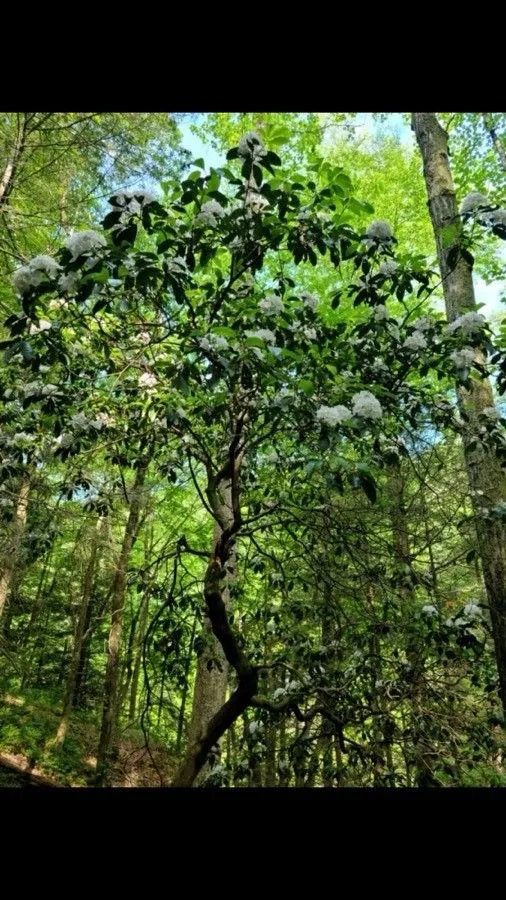
Author: L.
Bibliography: Sp. Pl.: 391 (1753)
Year: 1753
Status: accepted
Rank: species
Genus: Kalmia
Vegetable: False
Observations: E. U.S.A.
Calico-bush, scientifically known as Kalmia latifolia, is a beloved plant native to the eastern United States that captivates with its stunning floral display and evergreen foliage. First officially documented in 1753, this perennial evergreen shrub belongs to the Ericaceae family, renowned for its ornamental and ecological significance.
Kalmia latifolia typically grows in an assortment of natural habitats ranging from mountainous regions to shaded woodlands. It thrives particularly well in acidic, well-drained soils, and often flourishes in the understory of deciduous forests where its unique beauty complements the existing flora.
The Calico-bush is distinguished by its striking, cup-shaped flowers which bloom from late spring to early summer. These flowers, ranging in color from pink to white with intricate markings, are arranged in dense, showy clusters that create a spectacular visual effect. The evergreen leaves are lance-shaped and leathery, providing a lush green backdrop throughout the year, even when the plant is not in bloom.
Apart from its aesthetic appeal, the Calico-bush is also valued for its adaptability and resilience. It can tolerate a variety of environmental conditions, although it prefers partial shade to full sun. This versatility makes it a favored choice for gardeners and landscapers looking to add year-round beauty to residential and public gardens.
Caution is advised, however, as all parts of Kalmia latifolia are toxic if ingested. This aspect underscores the importance of mindful placement, especially in gardens frequented by children and pets.
In environment and culture, the Calico-bush plays a significant role. Its thick foliage provides habitat and cover for various wildlife, while its flowers attract a multitude of pollinators, thereby contributing to the health of local ecosystems.
In conclusion, the Calico-bush (Kalmia latifolia) is a plant of notable beauty and practicality. Appreciated for its evergreen foliage and spectacular blooms, it has earned a respected place in garden design and natural landscapes across the eastern United States. Whether for its aesthetic contribution or ecological benefits, Kalmia latifolia remains a cherished and fascinating species within the Ericaceae family.
Eng: calico-bush, mountain laurel, mountain-laurel, spoonwood
Swe: bredbladig kalmia
Fra: kalmia à feuilles larges
Cym: calmia llydanddail
En: Calico-bush, Mountain-laurel, Spoonwood, Chamaedaphne foliis tini floribus bullatis umbellatis, Mountain laurel, Calicobush, Ivybush, Calico Bush, Clamoun, Lambkill, Sheep Laurel
Ar: كلمية عريضة الأوراق
Bg: Американски лавър
Hr: Gorski lovor
Fi: Leveälehtikalmia
Fr: Kalmie à larges feuilles, Kalmie, Laurier d’Amérique, Laurier des Montagnes, Kalmia à feuilles larges
He: קלמיה לאטיפוליה
Fa: کالمیا لاتیفولیا
Ru: Кальмия широколистная
Sv: Bredbladig kalmia
Cy: Calmia llydanddail
Taken Jun 26, 2019 by tom tom ahern (cc-by-sa)
Taken Jan 31, 2021 by morley jake (cc-by-sa)
Taken Aug 30, 2020 by Camille Letellier (cc-by-sa)
Taken Jun 1, 2021 by Don Sadowsky (cc-by-sa)
Taken May 25, 2017 by Carolina Malabet (cc-by-sa)
Taken Jan 31, 2021 by neilzebub (cc-by-sa)
Taken Jan 31, 2021 by neilzebub (cc-by-sa)
Taken Jun 7, 2019 by David David (cc-by-sa)
Taken Jun 21, 2021 by Camille Durand (cc-by-sa)
Taken Sep 29, 2019 by Alexis Balthazar (cc-by-sa)
© copyright of the Board of Trustees of the Royal Botanic Gardens, Kew.
© copyright of the Board of Trustees of the Royal Botanic Gardens, Kew.
© copyright of the Board of Trustees of the Royal Botanic Gardens, Kew.
Taken May 30, 2019 by Wilhelm Rogmann (cc-by-sa)
Taken Apr 24, 2021 by abbott colin (cc-by-sa)
Taken Jul 12, 2019 by Spicy (cc-by-sa)
Taken Dec 23, 2020 by solazy (cc-by-sa)
Taken Mar 13, 2021 by Matthias Foellmer (cc-by-sa)
Taken Oct 29, 2020 by cabral felipe (cc-by-sa)
Taken May 27, 2022 by Manuëlle (cc-by-sa)
Taken Aug 30, 2020 by Camille Letellier (cc-by-sa)
Taken Aug 6, 2021 by Kathy Persaud (cc-by-sa)
Taken Mar 13, 2021 by Matthias Foellmer (cc-by-sa)
Taken Jan 1, 1900 by EOL − WVU Herbarium (cc-by-nc-sa)
Taken Jan 1, 1900 by EOL − Kristen Van Neste (cc-by-nc-sa)
Taken Jan 1, 1900 by EOL − Kristen Van Neste (cc-by-nc-sa)
Taken Jul 14, 2015 by EOL − anewman (cc-by-nc)
Taken Mar 13, 2021 by Matthias Foellmer (cc-by-sa)
Taken Apr 25, 2019 by Mike Williams (cc-by-sa)
Growth form: Multiple Stem
Growth habit: Tree, Shrub
Growth rate: Slow
Ph maximum: 5.5
Ph minimum: 4.5
Family: Myrtaceae Author: (F.Muell.) K.D.Hill & L.A.S.Johnson Bibliography: Telopea 6: 402 (1995) Year: 1995 Status:…
Family: Rubiaceae Author: Pierre ex A.Froehner Bibliography: Notizbl. Bot. Gart. Berlin-Dahlem 1: 237 (1897) Year:…
Family: Sapindaceae Author: Koidz. Bibliography: J. Coll. Sci. Imp. Univ. Tokyo 32(1): 38 (1911) Year:…
Family: Asteraceae Author: A.Gray Bibliography: Pacif. Railr. Rep.: 107 (1857) Year: 1857 Status: accepted Rank:…
Family: Fabaceae Author: Medik. Bibliography: Vorles. Churpfälz. Phys.-Ökon. Ges. 2: 398 (1787) Year: 1787 Status:…
Family: Aspleniaceae Author: (Cav.) Alston Bibliography: Bull. Misc. Inform. Kew 1932: 309 (1932) Year: 1932…